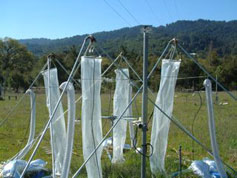

Thursday - May 3, 2007
SLAC Today is
available online at:
http://today.slac.stanford.edu
In this issue:
Research Thrives on Jasper Ridge
Science Today: The Danger of Inflation
Drell Elected to AAAS
Touring the Sciences as a Tour Guide
 |
 |
|
Thursday - May 3, 2007 |
Research Thrives on Jasper Ridge
These plastic tubes at one of the field plots of Jasper Ridge's global change experiment help researchers measure carbon uptake.
Less than a mile from the linear accelerator, cormorants, great blue herons, and coots congregate at Searsville Lake, while California quail emerge from coyote brush and red-winged blackbirds sing. Jasper Ridge Biological Preserve is a 1200-acre thriving research site that lies on the south side of the SLAC linac and west of Highway 280. The area is a living laboratory of plants and animals. The research conducted here is as varied as the preserve's habitats.
"For its size, Jasper Ridge is remarkably diverse," said research coordinator Nona Chiariello. "There are so many plant communities: chaparral, grassland, oak woodland, riparian and serpentine grassland. It's outstanding for both teaching and research."
|
||
|
|
||
 The Danger of InflationThe theory of cosmic inflation has been very successful in explaining the flatness of the universe and the large-scale distribution of matter. This is a part of the beautiful success of the current Standard Models of particle physics and cosmology. Still, we have many reasons to believe that the Standard Model of particle physics is incomplete and to expect that new particles and forces will soon be discovered. Earlier articles on these pages have described models of particle physics beyond the Standard Model based on supersymmetry, extra dimensions, and other marvelous principles. But in all of these theories, we have to worry, like the Federal Reserve, about the danger of inflation. Unlike the economy, though, the danger here is not that the universe will overheat but that it will cool down in the wrong way. I have been particularly worried about theories with supersymmetry, which I find an attractive route to new models of particle physics. Supersymmetry generalizes the Standard Model by adding a new particle with the opposite statistics for every known particle. We add, then, a fermionic photon (which could be the cosmic dark matter) and bosonic electrons and quarks, which could help to explain the origin of the W and Z boson masses. The theory has many other successes, including a connection to the idea of Grand Unification.
But there is a problem.
At high temperature, in the very early universe after the Big Bang,
the universe starts in a very symmetrical state.
Broken symmetry is needed to give mass to the W and Z and to the
quark and leptons.
But a supersymmetric model often has many different possible broken
symmetry states.
During inflation, the universe cools rapidly, and it can easily become stuck
in the wrong configuration.
This would cause irreparable damage.
|
Drell Elected to AAAS
Tour the Sciences
|
Events (see all | submit)
Access (see all)
Announcements
|
| | ||
|
|
||
 <%
Response.AddHeader "Last-modified", getArticleDate()
'Response.AddHeader "Last-modified","Mon, 01 Sep 1997 01:03:33 GMT"
'Monday, December 06, 2010
%>
<%
Response.AddHeader "Last-modified", getArticleDate()
'Response.AddHeader "Last-modified","Mon, 01 Sep 1997 01:03:33 GMT"
'Monday, December 06, 2010
%>View online at http://today.slac.stanford.edu/. |
||